Analysis of Iron Ore Demand and Supply in the Australian Economy
VerifiedAdded on 2020/03/04
|7
|1420
|70
Report
AI Summary
This report provides an analysis of the demand and supply dynamics of iron ore in Australia. It examines the current market trends, emphasizing the expected rise in demand, particularly from China and India. The report applies economic theory, including the laws of demand and supply, to explain how changes in demand and supply affect iron ore prices. It highlights the relatively low elasticity of supply for iron ore due to its nature as a scarce natural resource, leading to potential price increases. The report also discusses the positive implications of increased demand for the Australian economy, including higher export revenues and improved balance of payments. Finally, the report suggests the importance of government strategies to promote both domestic and international demand for iron ore to foster economic growth and government revenue.
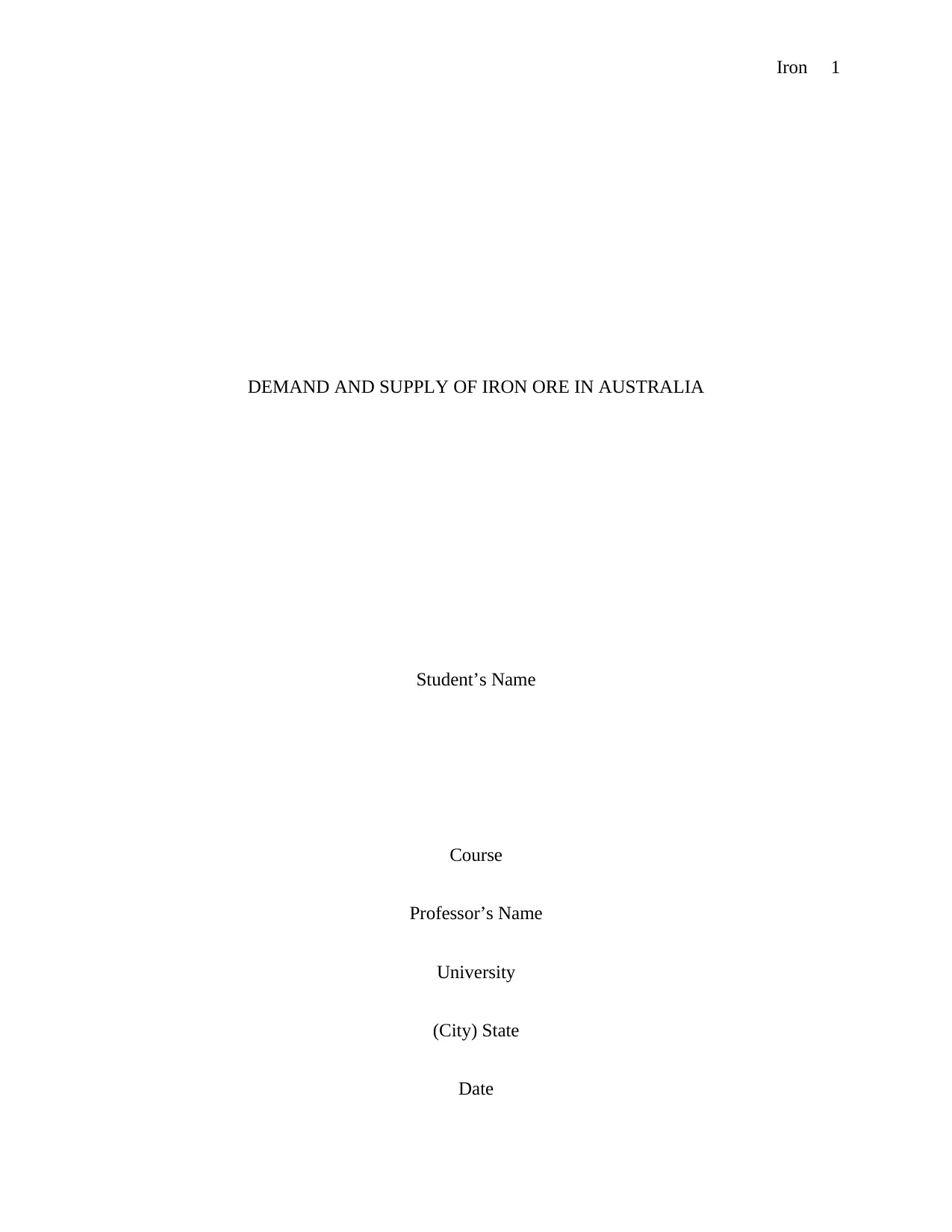
Iron 1
DEMAND AND SUPPLY OF IRON ORE IN AUSTRALIA
Student’s Name
Course
Professor’s Name
University
(City) State
Date
DEMAND AND SUPPLY OF IRON ORE IN AUSTRALIA
Student’s Name
Course
Professor’s Name
University
(City) State
Date
Paraphrase This Document
Need a fresh take? Get an instant paraphrase of this document with our AI Paraphraser
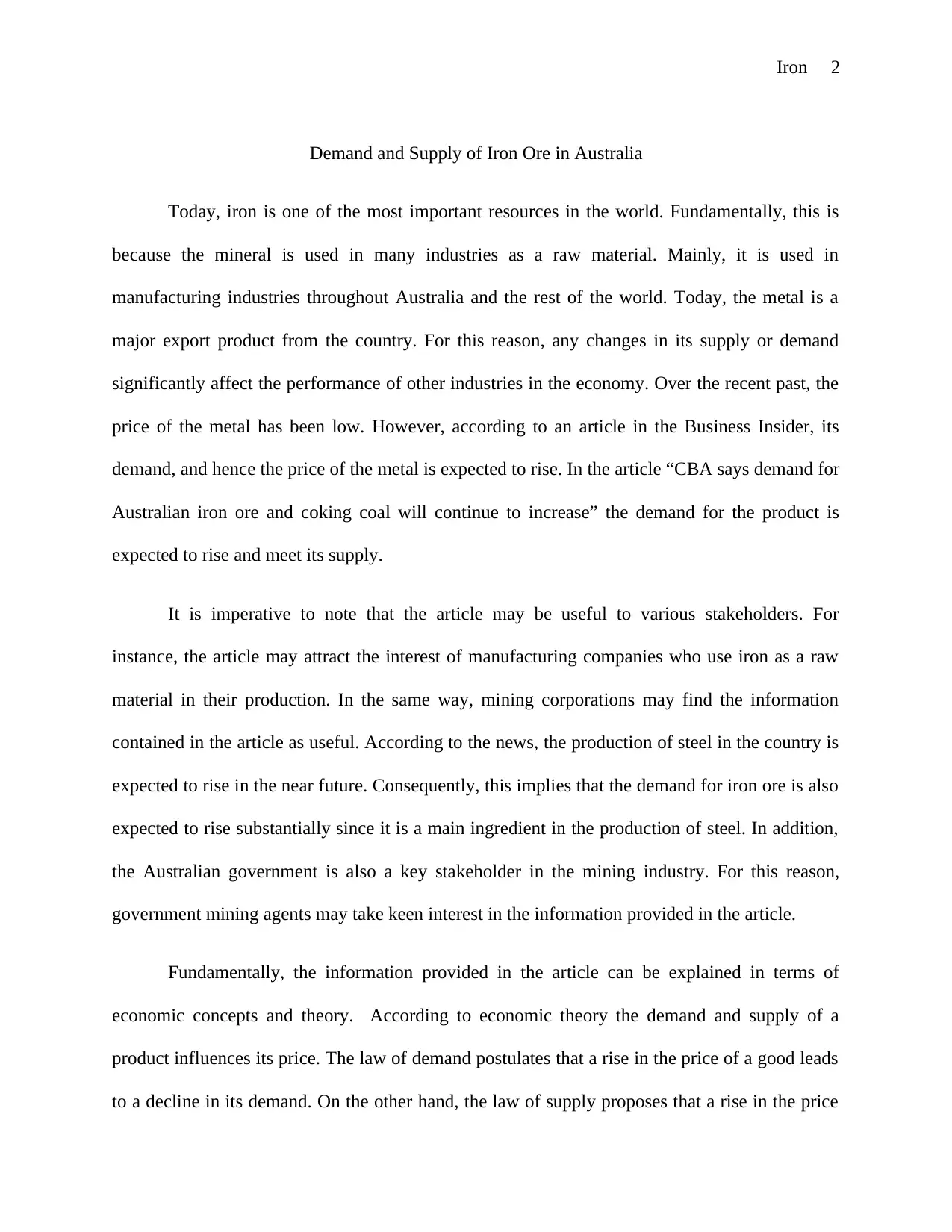
Iron 2
Demand and Supply of Iron Ore in Australia
Today, iron is one of the most important resources in the world. Fundamentally, this is
because the mineral is used in many industries as a raw material. Mainly, it is used in
manufacturing industries throughout Australia and the rest of the world. Today, the metal is a
major export product from the country. For this reason, any changes in its supply or demand
significantly affect the performance of other industries in the economy. Over the recent past, the
price of the metal has been low. However, according to an article in the Business Insider, its
demand, and hence the price of the metal is expected to rise. In the article “CBA says demand for
Australian iron ore and coking coal will continue to increase” the demand for the product is
expected to rise and meet its supply.
It is imperative to note that the article may be useful to various stakeholders. For
instance, the article may attract the interest of manufacturing companies who use iron as a raw
material in their production. In the same way, mining corporations may find the information
contained in the article as useful. According to the news, the production of steel in the country is
expected to rise in the near future. Consequently, this implies that the demand for iron ore is also
expected to rise substantially since it is a main ingredient in the production of steel. In addition,
the Australian government is also a key stakeholder in the mining industry. For this reason,
government mining agents may take keen interest in the information provided in the article.
Fundamentally, the information provided in the article can be explained in terms of
economic concepts and theory. According to economic theory the demand and supply of a
product influences its price. The law of demand postulates that a rise in the price of a good leads
to a decline in its demand. On the other hand, the law of supply proposes that a rise in the price
Demand and Supply of Iron Ore in Australia
Today, iron is one of the most important resources in the world. Fundamentally, this is
because the mineral is used in many industries as a raw material. Mainly, it is used in
manufacturing industries throughout Australia and the rest of the world. Today, the metal is a
major export product from the country. For this reason, any changes in its supply or demand
significantly affect the performance of other industries in the economy. Over the recent past, the
price of the metal has been low. However, according to an article in the Business Insider, its
demand, and hence the price of the metal is expected to rise. In the article “CBA says demand for
Australian iron ore and coking coal will continue to increase” the demand for the product is
expected to rise and meet its supply.
It is imperative to note that the article may be useful to various stakeholders. For
instance, the article may attract the interest of manufacturing companies who use iron as a raw
material in their production. In the same way, mining corporations may find the information
contained in the article as useful. According to the news, the production of steel in the country is
expected to rise in the near future. Consequently, this implies that the demand for iron ore is also
expected to rise substantially since it is a main ingredient in the production of steel. In addition,
the Australian government is also a key stakeholder in the mining industry. For this reason,
government mining agents may take keen interest in the information provided in the article.
Fundamentally, the information provided in the article can be explained in terms of
economic concepts and theory. According to economic theory the demand and supply of a
product influences its price. The law of demand postulates that a rise in the price of a good leads
to a decline in its demand. On the other hand, the law of supply proposes that a rise in the price
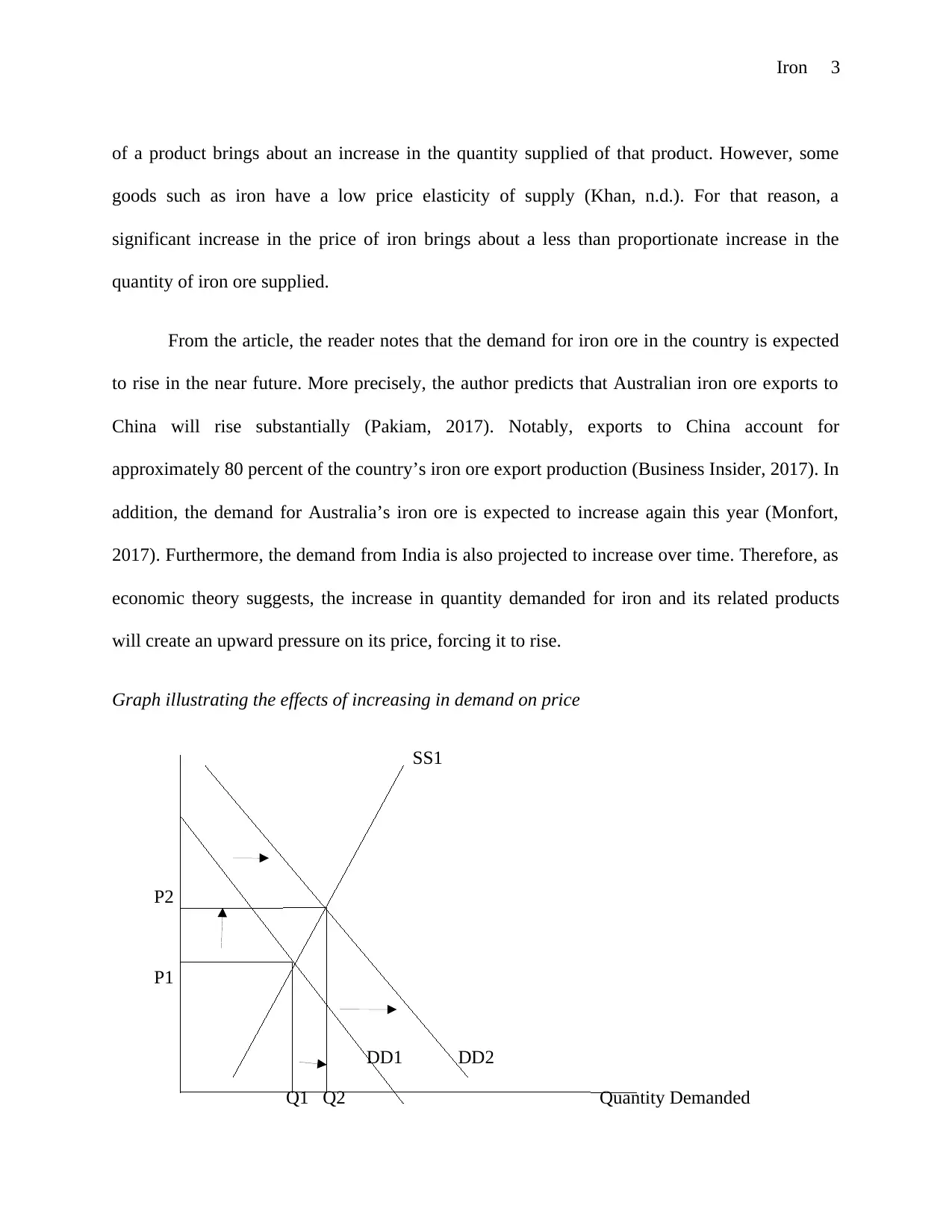
Iron 3
of a product brings about an increase in the quantity supplied of that product. However, some
goods such as iron have a low price elasticity of supply (Khan, n.d.). For that reason, a
significant increase in the price of iron brings about a less than proportionate increase in the
quantity of iron ore supplied.
From the article, the reader notes that the demand for iron ore in the country is expected
to rise in the near future. More precisely, the author predicts that Australian iron ore exports to
China will rise substantially (Pakiam, 2017). Notably, exports to China account for
approximately 80 percent of the country’s iron ore export production (Business Insider, 2017). In
addition, the demand for Australia’s iron ore is expected to increase again this year (Monfort,
2017). Furthermore, the demand from India is also projected to increase over time. Therefore, as
economic theory suggests, the increase in quantity demanded for iron and its related products
will create an upward pressure on its price, forcing it to rise.
Graph illustrating the effects of increasing in demand on price
SS1
P2
P1
DD1 DD2
Q1 Q2 Quantity Demanded
of a product brings about an increase in the quantity supplied of that product. However, some
goods such as iron have a low price elasticity of supply (Khan, n.d.). For that reason, a
significant increase in the price of iron brings about a less than proportionate increase in the
quantity of iron ore supplied.
From the article, the reader notes that the demand for iron ore in the country is expected
to rise in the near future. More precisely, the author predicts that Australian iron ore exports to
China will rise substantially (Pakiam, 2017). Notably, exports to China account for
approximately 80 percent of the country’s iron ore export production (Business Insider, 2017). In
addition, the demand for Australia’s iron ore is expected to increase again this year (Monfort,
2017). Furthermore, the demand from India is also projected to increase over time. Therefore, as
economic theory suggests, the increase in quantity demanded for iron and its related products
will create an upward pressure on its price, forcing it to rise.
Graph illustrating the effects of increasing in demand on price
SS1
P2
P1
DD1 DD2
Q1 Q2 Quantity Demanded
⊘ This is a preview!⊘
Do you want full access?
Subscribe today to unlock all pages.

Trusted by 1+ million students worldwide
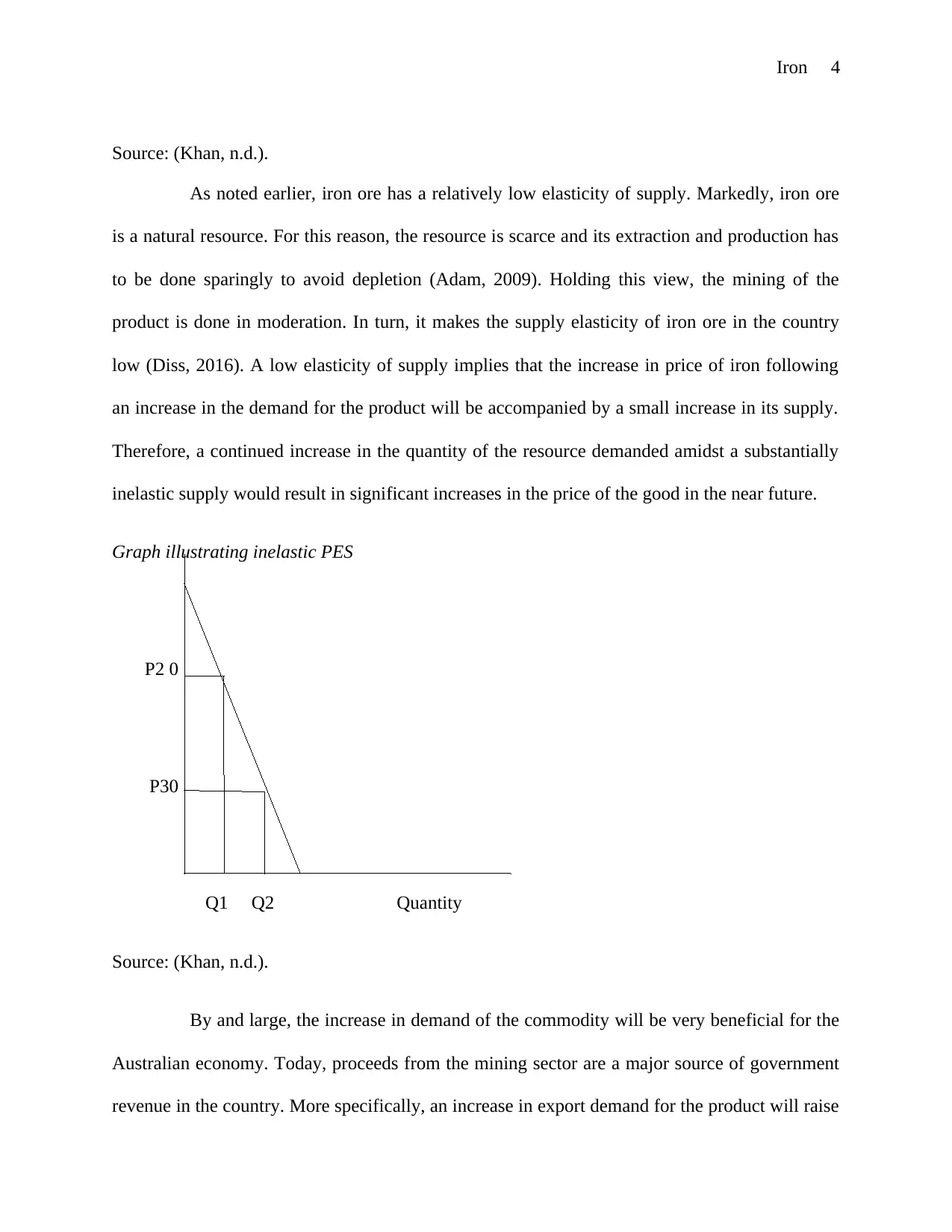
Iron 4
Source: (Khan, n.d.).
As noted earlier, iron ore has a relatively low elasticity of supply. Markedly, iron ore
is a natural resource. For this reason, the resource is scarce and its extraction and production has
to be done sparingly to avoid depletion (Adam, 2009). Holding this view, the mining of the
product is done in moderation. In turn, it makes the supply elasticity of iron ore in the country
low (Diss, 2016). A low elasticity of supply implies that the increase in price of iron following
an increase in the demand for the product will be accompanied by a small increase in its supply.
Therefore, a continued increase in the quantity of the resource demanded amidst a substantially
inelastic supply would result in significant increases in the price of the good in the near future.
Graph illustrating inelastic PES
P2 0
P30
Q1 Q2 Quantity
Source: (Khan, n.d.).
By and large, the increase in demand of the commodity will be very beneficial for the
Australian economy. Today, proceeds from the mining sector are a major source of government
revenue in the country. More specifically, an increase in export demand for the product will raise
Source: (Khan, n.d.).
As noted earlier, iron ore has a relatively low elasticity of supply. Markedly, iron ore
is a natural resource. For this reason, the resource is scarce and its extraction and production has
to be done sparingly to avoid depletion (Adam, 2009). Holding this view, the mining of the
product is done in moderation. In turn, it makes the supply elasticity of iron ore in the country
low (Diss, 2016). A low elasticity of supply implies that the increase in price of iron following
an increase in the demand for the product will be accompanied by a small increase in its supply.
Therefore, a continued increase in the quantity of the resource demanded amidst a substantially
inelastic supply would result in significant increases in the price of the good in the near future.
Graph illustrating inelastic PES
P2 0
P30
Q1 Q2 Quantity
Source: (Khan, n.d.).
By and large, the increase in demand of the commodity will be very beneficial for the
Australian economy. Today, proceeds from the mining sector are a major source of government
revenue in the country. More specifically, an increase in export demand for the product will raise
Paraphrase This Document
Need a fresh take? Get an instant paraphrase of this document with our AI Paraphraser
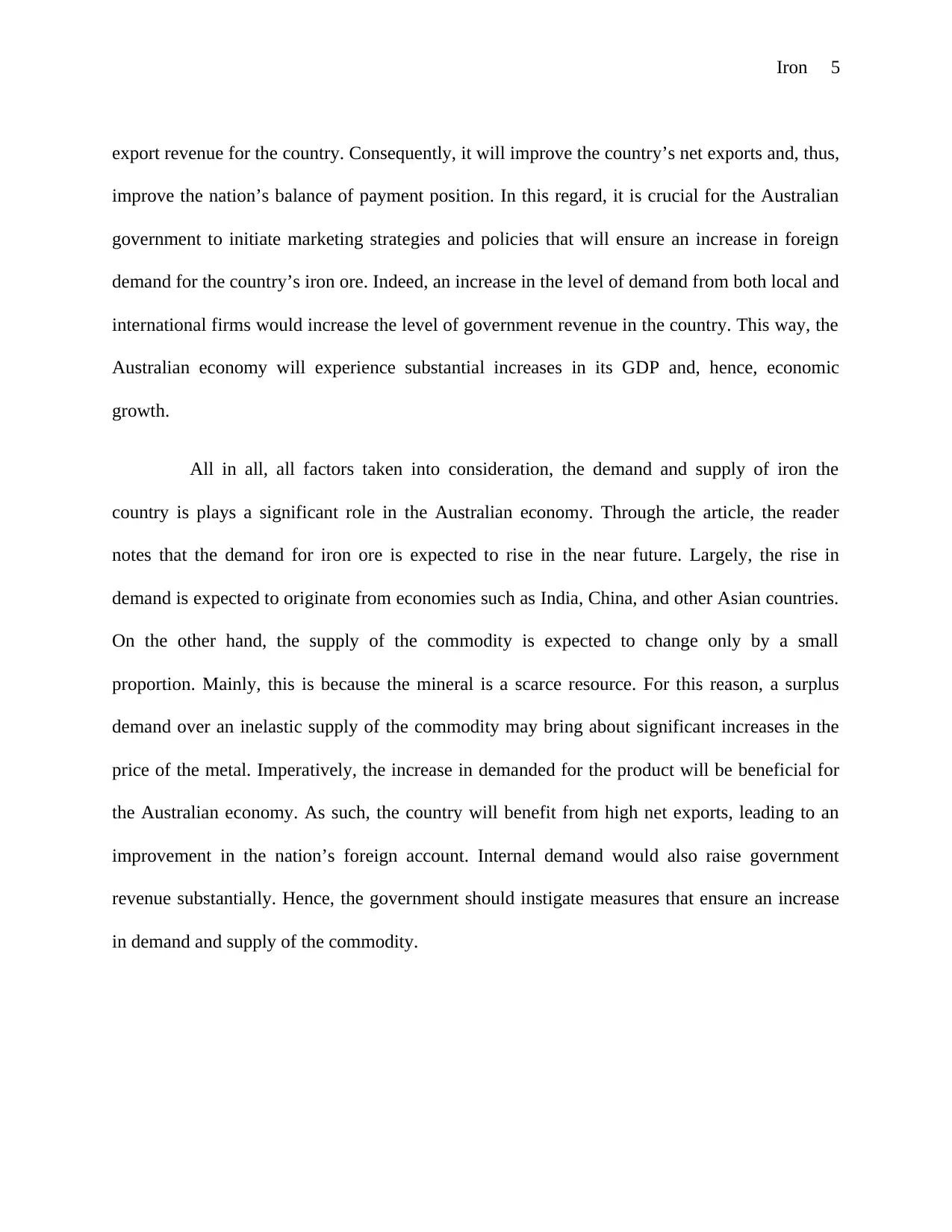
Iron 5
export revenue for the country. Consequently, it will improve the country’s net exports and, thus,
improve the nation’s balance of payment position. In this regard, it is crucial for the Australian
government to initiate marketing strategies and policies that will ensure an increase in foreign
demand for the country’s iron ore. Indeed, an increase in the level of demand from both local and
international firms would increase the level of government revenue in the country. This way, the
Australian economy will experience substantial increases in its GDP and, hence, economic
growth.
All in all, all factors taken into consideration, the demand and supply of iron the
country is plays a significant role in the Australian economy. Through the article, the reader
notes that the demand for iron ore is expected to rise in the near future. Largely, the rise in
demand is expected to originate from economies such as India, China, and other Asian countries.
On the other hand, the supply of the commodity is expected to change only by a small
proportion. Mainly, this is because the mineral is a scarce resource. For this reason, a surplus
demand over an inelastic supply of the commodity may bring about significant increases in the
price of the metal. Imperatively, the increase in demanded for the product will be beneficial for
the Australian economy. As such, the country will benefit from high net exports, leading to an
improvement in the nation’s foreign account. Internal demand would also raise government
revenue substantially. Hence, the government should instigate measures that ensure an increase
in demand and supply of the commodity.
export revenue for the country. Consequently, it will improve the country’s net exports and, thus,
improve the nation’s balance of payment position. In this regard, it is crucial for the Australian
government to initiate marketing strategies and policies that will ensure an increase in foreign
demand for the country’s iron ore. Indeed, an increase in the level of demand from both local and
international firms would increase the level of government revenue in the country. This way, the
Australian economy will experience substantial increases in its GDP and, hence, economic
growth.
All in all, all factors taken into consideration, the demand and supply of iron the
country is plays a significant role in the Australian economy. Through the article, the reader
notes that the demand for iron ore is expected to rise in the near future. Largely, the rise in
demand is expected to originate from economies such as India, China, and other Asian countries.
On the other hand, the supply of the commodity is expected to change only by a small
proportion. Mainly, this is because the mineral is a scarce resource. For this reason, a surplus
demand over an inelastic supply of the commodity may bring about significant increases in the
price of the metal. Imperatively, the increase in demanded for the product will be beneficial for
the Australian economy. As such, the country will benefit from high net exports, leading to an
improvement in the nation’s foreign account. Internal demand would also raise government
revenue substantially. Hence, the government should instigate measures that ensure an increase
in demand and supply of the commodity.
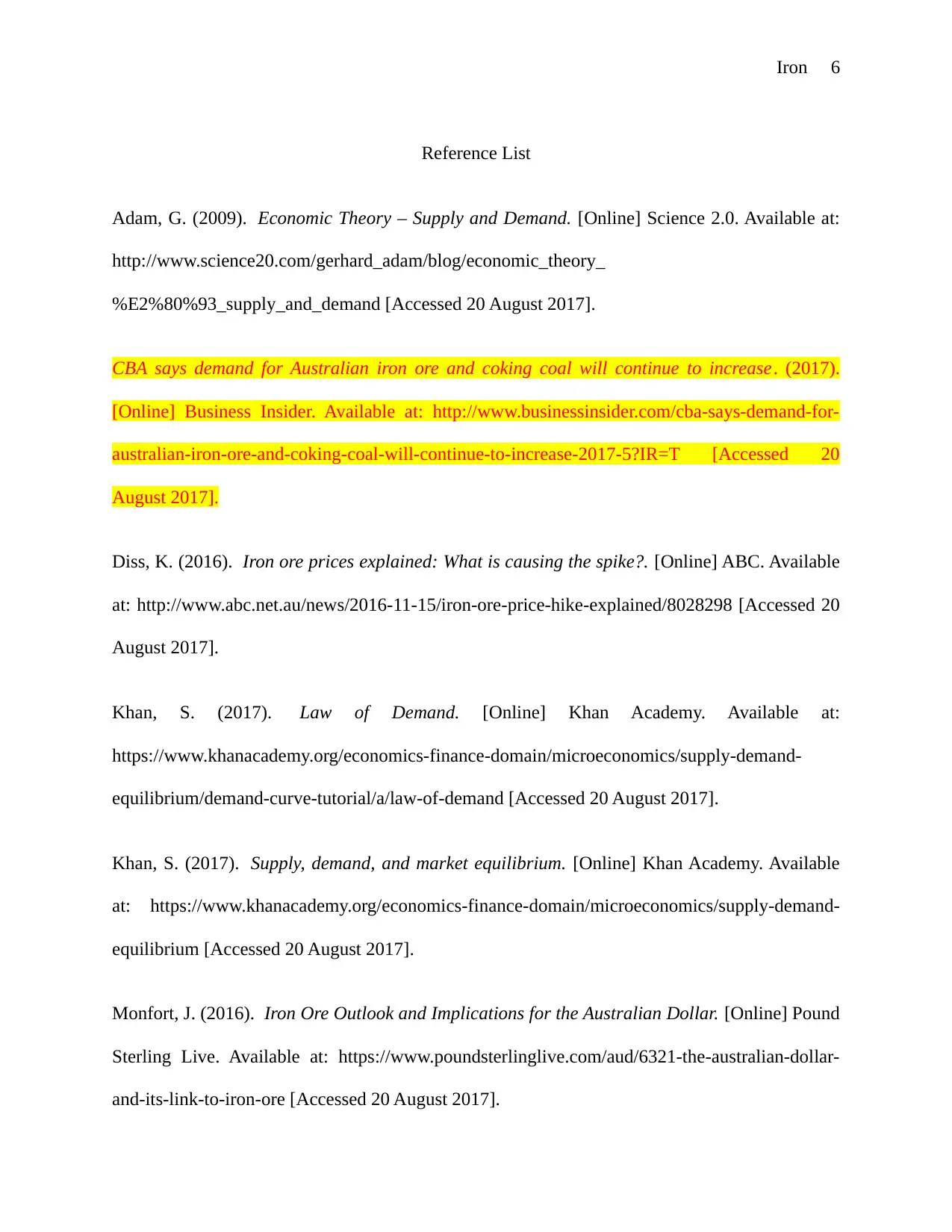
Iron 6
Reference List
Adam, G. (2009). Economic Theory – Supply and Demand. [Online] Science 2.0. Available at:
http://www.science20.com/gerhard_adam/blog/economic_theory_
%E2%80%93_supply_and_demand [Accessed 20 August 2017].
CBA says demand for Australian iron ore and coking coal will continue to increase. (2017).
[Online] Business Insider. Available at: http://www.businessinsider.com/cba-says-demand-for-
australian-iron-ore-and-coking-coal-will-continue-to-increase-2017-5?IR=T [Accessed 20
August 2017].
Diss, K. (2016). Iron ore prices explained: What is causing the spike?. [Online] ABC. Available
at: http://www.abc.net.au/news/2016-11-15/iron-ore-price-hike-explained/8028298 [Accessed 20
August 2017].
Khan, S. (2017). Law of Demand. [Online] Khan Academy. Available at:
https://www.khanacademy.org/economics-finance-domain/microeconomics/supply-demand-
equilibrium/demand-curve-tutorial/a/law-of-demand [Accessed 20 August 2017].
Khan, S. (2017). Supply, demand, and market equilibrium. [Online] Khan Academy. Available
at: https://www.khanacademy.org/economics-finance-domain/microeconomics/supply-demand-
equilibrium [Accessed 20 August 2017].
Monfort, J. (2016). Iron Ore Outlook and Implications for the Australian Dollar. [Online] Pound
Sterling Live. Available at: https://www.poundsterlinglive.com/aud/6321-the-australian-dollar-
and-its-link-to-iron-ore [Accessed 20 August 2017].
Reference List
Adam, G. (2009). Economic Theory – Supply and Demand. [Online] Science 2.0. Available at:
http://www.science20.com/gerhard_adam/blog/economic_theory_
%E2%80%93_supply_and_demand [Accessed 20 August 2017].
CBA says demand for Australian iron ore and coking coal will continue to increase. (2017).
[Online] Business Insider. Available at: http://www.businessinsider.com/cba-says-demand-for-
australian-iron-ore-and-coking-coal-will-continue-to-increase-2017-5?IR=T [Accessed 20
August 2017].
Diss, K. (2016). Iron ore prices explained: What is causing the spike?. [Online] ABC. Available
at: http://www.abc.net.au/news/2016-11-15/iron-ore-price-hike-explained/8028298 [Accessed 20
August 2017].
Khan, S. (2017). Law of Demand. [Online] Khan Academy. Available at:
https://www.khanacademy.org/economics-finance-domain/microeconomics/supply-demand-
equilibrium/demand-curve-tutorial/a/law-of-demand [Accessed 20 August 2017].
Khan, S. (2017). Supply, demand, and market equilibrium. [Online] Khan Academy. Available
at: https://www.khanacademy.org/economics-finance-domain/microeconomics/supply-demand-
equilibrium [Accessed 20 August 2017].
Monfort, J. (2016). Iron Ore Outlook and Implications for the Australian Dollar. [Online] Pound
Sterling Live. Available at: https://www.poundsterlinglive.com/aud/6321-the-australian-dollar-
and-its-link-to-iron-ore [Accessed 20 August 2017].
⊘ This is a preview!⊘
Do you want full access?
Subscribe today to unlock all pages.

Trusted by 1+ million students worldwide
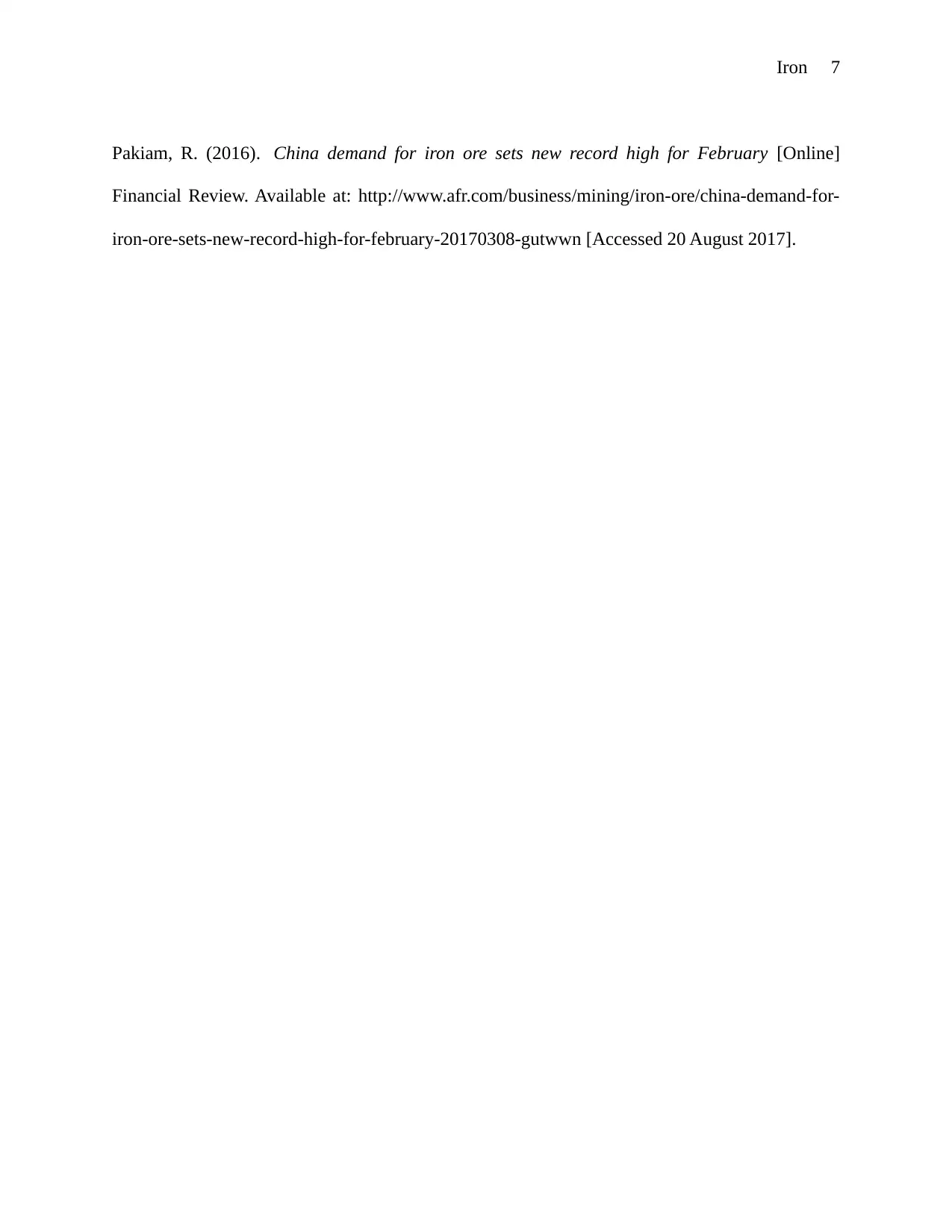
Iron 7
Pakiam, R. (2016). China demand for iron ore sets new record high for February [Online]
Financial Review. Available at: http://www.afr.com/business/mining/iron-ore/china-demand-for-
iron-ore-sets-new-record-high-for-february-20170308-gutwwn [Accessed 20 August 2017].
Pakiam, R. (2016). China demand for iron ore sets new record high for February [Online]
Financial Review. Available at: http://www.afr.com/business/mining/iron-ore/china-demand-for-
iron-ore-sets-new-record-high-for-february-20170308-gutwwn [Accessed 20 August 2017].
1 out of 7
Related Documents
Your All-in-One AI-Powered Toolkit for Academic Success.
+13062052269
info@desklib.com
Available 24*7 on WhatsApp / Email
![[object Object]](/_next/static/media/star-bottom.7253800d.svg)
Unlock your academic potential
Copyright © 2020–2025 A2Z Services. All Rights Reserved. Developed and managed by ZUCOL.




